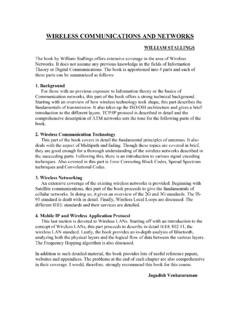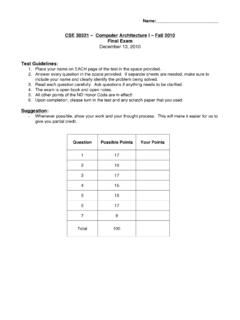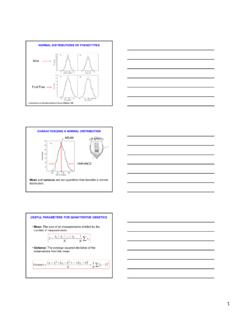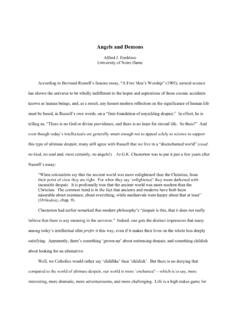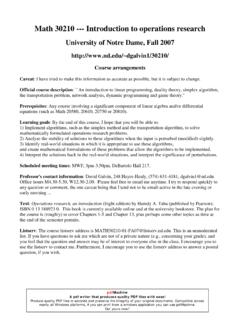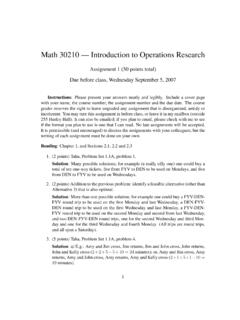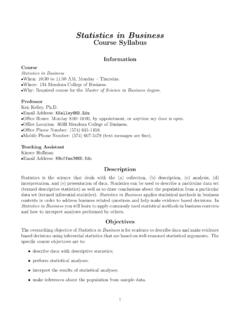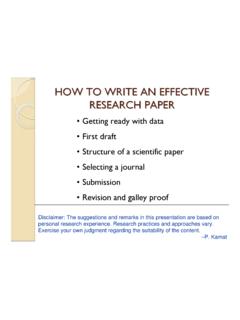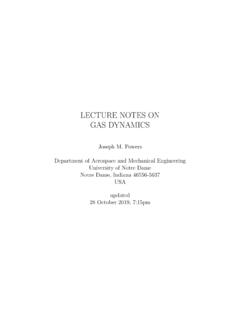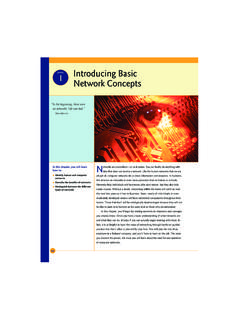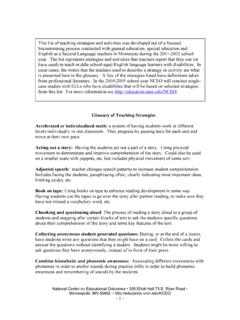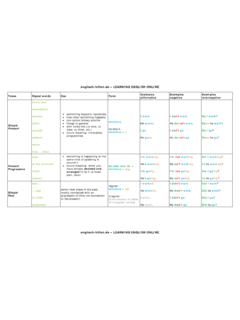Transcription of The Tongue and Quill - University of Notre Dame
1 The Tongue and Quill AFH 33-337 27 May 2015 Air Force Core Values Integrity First, Service Before Self, and Excellence in All We Do. Acknowledgement The Tongue and Quill has been a valued Air Force resource for decades and many Airmen from our Total Force of uniformed and civilian members have contributed their talents to various editions over the years. This revision is built upon the foundation of governing directives and user s inputs from the unit level all the way up to Headquarters Air Force. A small team of Total Force Airmen from the Air University , the United States Air Force Academy, Headquarters Air Education and Training Command (AETC), the Air Force Reserve Command (AFRC), Air National Guard (ANG), and Headquarters Air Force compiled inputs from the field and rebuilt The Tongue and Quill to meet the needs of today s Airmen. The team put many hours into this effort over a span of almost two years to improve the content, relevance, and organization of material throughout this handbook.
2 As the final files go to press it is the desire of The Tongue and Quill team to say thank you to every Airman who assisted in making this edition better; you have our sincere appreciation! The Tongue and Quill Team BY ORDER OF THE AIR FORCE HANDBOOK 33-337 SECRETARY OF THE AIR FORCE 27 MAY 2015 Communications and Information THE Tongue AND Quill ACCESSIBILITY: Publications and forms are available for downloading or ordering on the e-Publishing website at RELEASABILITY: There are no releasability restrictions on this publication. OPR: SAF/CIO A6SS Certified by: SAF/CIO A6SS (Col Heather L. McGee) Supersedes: AFH33-337, 1 August 2004 Pages: 378 The men and women of the United States Air Force must communicate clearly and effectively to carry out our missions. Although we live in an era of rapid personal and mass communication that was barely imagined just a few years ago, our Air Force still requires face-to-face briefings, background papers, and staff packages to keep the mission moving forward.
3 This handbook, together with Air Force Manual (AFMAN) 33-326, Preparing Official Communications, provides the information to ensure clear communications written or spoken. Send recommended changes or comments using AF Form 847, Recommendation for Change of Publication, to the Air Force Cyberspace Strategy & Policy Division (SAF/CIO A6SS) at Ensure that all records created as a result of processes prescribed in this publication are maintained IAW AFMAN 33-363, Management of Records, and disposed of IAW the Air Force Records Disposition Schedule (RDS) in the Air Force Records Information Management System (AFRIMS). The use of the name or mark of any specific manufacturer, commercial product, commodity, or service in this publication does not imply endorsement by the Air Force. SUMMARY OF REVISIONS This edition has been substantially revised to 1) standardize the format and layout for readability; 2) improve the organization of chapters and content within each chapter; 3) provide additional material on preparing to write and speak, writing with focus, communicating to persuade, research, meetings, briefings and listening; 4) clarify guidance for Air Force written products with formatted examples for each product; 5) add information on Air Force written products such as awards, decorations and performance reports; and 6) update guidance for electronic communications.
4 The Tongue and Quill AFH 33-337, 27 MAY 2015 Table of Contents PART I: COMMUNICATION BASICS .. 1 Plain Language Requirement: It s the Law .. 2 Plain Language in the Air Force: Be Clear, Concise and Specific .. 2 CHAPTER 1: A Basic Philosophy of Communication .. 3 What Do We Mean by Communication? .. 4 Communication, Teamwork and Leadership .. 5 Principles of Effective Communication .. 5 CHAPTER 2: Seven Steps to Effective Communication (Overview) .. 8 Preparing to Write and Speak (Steps 1-4) .. 9 Drafting, Editing, and Feedback (Steps 5-7) .. 11 Seven Steps to Effective Communication: Quick Reference List .. 13 PART II: PREPARING TO WRITE AND SPEAK .. 14 CHAPTER 3: Step 1 (Analyze Purpose and Audience) .. 15 Key Questions .. 16 What Is My Purpose? .. 16 Drafting a Purpose Statement .. 17 Analyzing Purpose: Other Issues .. 18 Audience Analysis: The Human Factor .. 18 Tips For Success.
5 20 CHAPTER 4: Step 2 (Research Your Topic) .. 23 Start Smart .. 24 Getting 25 Search Engines and Databases .. 26 Evaluate Your Sources .. 30 Useful Online Resources .. 31 CHAPTER 5: Step 3 (Support Your Ideas) .. 41 The Logic of Arguments: Fundamentals .. 42 Evidence: Proving Your Point .. 44 Characteristics of Good Supporting Evidence .. 45 Logical Errors: Flawed Arguments .. 46 Arguments, Truth and Persuasion .. 52 CHAPTER 6: Step 4 (Organize and Outline) .. 53 Organizing: Finalizing Your Purpose Statement and Bottom Line .. 54 The Outline: Why Do I Need One? .. 55 Outlining the Body: Pick a Pattern .. 59 - ii - The Tongue and Quill AFH 33-337, 27 MAY 2015 PART III: WRITING WITH FOCUS .. 63 CHAPTER 7: Step 5 (Draft) .. 65 Drafting: Basic Philosophy .. 66 Drafting Effective Paragraphs .. 69 Drafting Effective Sentences .. 73 Overcoming Writer s Block .. 90 CHAPTER 8: Step 6 (Edit).
6 91 Editing vs. Feedback .. 92 Editing Fundamentals .. 92 Editing Efficiently: A Three-Step Approach .. 93 Drafting Basics: Did You Apply Them? .. 96 Common Grammar Traps .. 97 Common Writing Errors .. 101 CHAPTER 9: Step 7 (Fight for Feedback and Get Approval) .. 103 Fighting For Feedback .. 104 Getting Approval: Staff Coordination .. 106 PART IV: FACE-TO-FACE COMMUNICATION .. 110 CHAPTER 10: Air Force Speaking .. 111 Verbal Communication .. 112 Non-Verbal Communication .. 113 Overcoming Anxiety: Some Simple Steps .. 114 Common Nonverbal Quirks .. 115 Delivery Formats: Impromptu, Prepared and Manuscript .. 115 Preparing Your Slides .. 118 CHAPTER 11: Effective Listening Strategies .. 123 Understanding Hearing and Listening .. 124 Informative, Critical and Empathic Listening .. 125 Better Listening .. 129 Overcoming Barriers to Listening .. 130 PART V: WORKPLACE CHALLENGES.
7 133 CHAPTER 12: Electronic Communications and Social Media .. 134 Electronic Mail (E-Mail) .. 135 Social Media .. 143 Instant Messaging (IM) and Texting .. 147 Telephones, Voice Mail and Fax .. 149 Electronic Communications Glossary .. 152 - iii - The Tongue and Quill AFH 337, 27 MAY 2015 CHAPTER 13: Meetings .. 155 Planning an Effective Meeting .. 156 Running Your Meeting .. 159 Group Dynamics and Fun .. 161 PART VI: DOCUMENT STANDARDS .. 163 CHAPTER 14: The Official Memorandum .. 165 The Heading Section .. 166 The Text of the Official Memorandum .. 171 The Closing Section .. 171 Additional Information .. 175 Attachments .. 176 The Official Memorandum: Examples .. 179 Spelling Checkers: Before You Sign .. 192 CHAPTER 15 The Personal Letter .. 193 The Heading Section .. 194 The Text of the Personal Letter .. 195 The Closing Section .. 195 Forms of Address, Salutation and Complimentary Close.
8 196 Military Ranks and Abbreviations .. 213 The Personal Letter: Examples .. 215 CHAPTER 16: Air Force Papers .. 221 Form and Function .. 221 Point Paper .. 224 Talking Paper .. 225 Bullet Background Paper .. 226 Background Paper .. 228 Position Paper .. 230 CHAPTER 17: The Staff Study .. 231 Purpose .. 231 Process: Critical Thinking and Problem 232 Writing the Report .. 234 Complete the Study .. 237 CHAPTER 18: The Staff 239 SSS Fundamentals .. 240 Completing the SSS Form .. 240 Assembling the Package .. 243 Coordinating the Package .. 244 Sample SSS and eSSS .. 245 - iv - The Tongue and Quill AFH 33-337, 27 MAY 2015 CHAPTER 19: Writing Better Bullet Statements .. 249 Getting Started .. 250 Drafting Accomplishment-Impact Bullet Statements .. 250 Polishing Accomplishment-Impact Bullet Statements .. 255 Bullet Statement Mechanics .. 258 CHAPTER 20: The Official Biography.
9 259 The Official Biography: Fundamentals .. 259 Getting Started .. 260 Associated Press (AP) Style Guidance for Official Biographies .. 260 Official Biography Elements .. 261 CHAPTER 21: The R sum .. 267 Function and Organization .. 268 Seven Steps to an Effective R sum .. 269 Things to Include .. 270 Things to Omit .. 271 The R sum Cover Letter .. 271 Examples .. 271 CHAPTER 22: Envelopes and Mail .. 277 Envelope Fundamentals .. 278 Envelope Anatomy .. 278 Address Format Standards .. 279 USPS Mail Terminology .. 283 CHAPTER 23: Air Force Publications/Forms .. 285 Dual Responsibilities in Developing Publications/Forms .. 285 Publications/Forms Process Overview .. 286 Plain Language Challenge .. 286 PART VII: WRITING MECHANICS .. 287 CHAPTER 24: Writing Terminology .. 289 Common Grammatical and Writing Terms .. 290 Irregular Verbs .. 296 CHAPTER 25: Punctuation .. 297 Punctuation: Why Do We Need It?
10 297 Open and Closed Punctuation .. 298 Punctuating Terms in a Series .. 298 Punctuation Usage Guide .. 299 - v - The Tongue and Quill AFH 337, 27 MAY 2015 CHAPTER 26: Abbreviations .. 334 Definition and Implications .. 335 Types of Abbreviations .. 335 General Guidelines .. 338 Common Abbreviations .. 339 Researcher s Guide to Abbreviations .. 344 CHAPTER 27: Capitalization .. 345 General Capitalization Guidelines .. 345 Specific Capitalization Guidelines .. 346 CHAPTER 28: Numbers .. 359 Three General Rules .. 359 Specific Guidance .. 360 Summing Things Up .. 366 - vi - PART I: Communication Basics PART I: COMMUNICATION BASICS - 1 - The Tongue and Quill AFH 337, 27 MAY 2015 Plain Language Requirement: It s the Law Agencies of the US Government have a long history of trying to improve their ability to communicate with the public they serve. Public Law 111-274, Plain Writing Act of 2010, is the most recent mandate to target unclear language in government documents.
